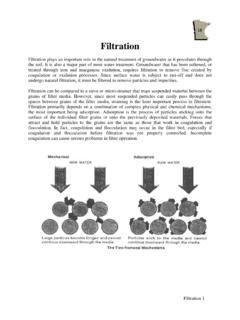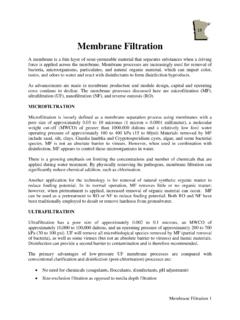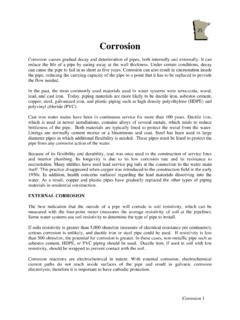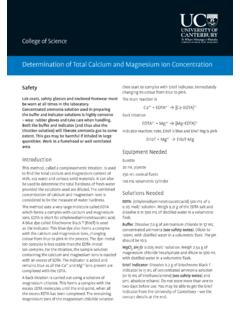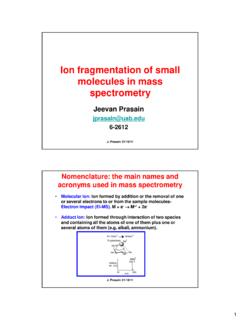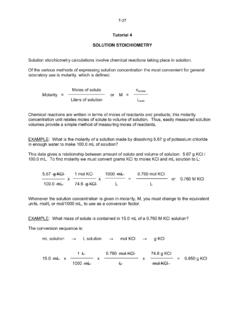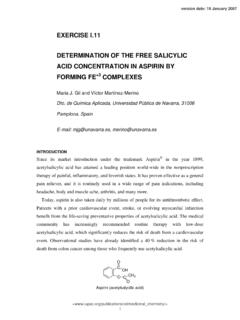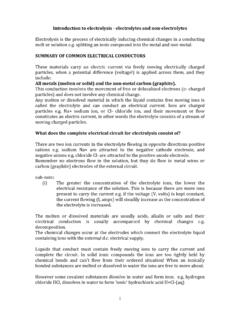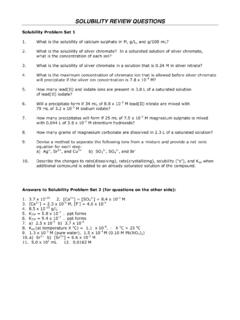Transcription of Zeolite Ion Exchange Softening - MRWA
1 Ion Exchange Softening 1 Ion Exchange Softening Ion- Exchange is used extensively in small water systems and individual homes. Ion- Exchange resin, ( Zeolite ) exchanges one ion from the water being treated for another ion that is in the resin (sodium is one component of Softening salt, with chlorine being the other). Zeolite resin exchanges sodium for calcium and magnesium. The following chemical reactions show the Exchange process, where X represents Zeolite , the Exchange material. Removal of carbonate hardness: Ca(HCO3)2 + Na2X ------> CaX + 2 NaHCO3 Mg(HCO3)2 + Na2X ------> MgX + 2 NaHCO3 Removal of non-carbonate hardness: CaSO4 + Na2X ----- > CaX + Na2SO4 CaCl2 + Na2X ------> CaX + CaCl2 MgSO4 + Na2X ------> MgX + Na2SO4 MgCL2 + Na2X ------> MgX + 2 NaC1 These reactions represent cation Exchange , the Exchange of positive ions.
2 To replenish the sodium ions used, units need to be regenerated with material containing high amounts of sodium, normally salt brine. This allows the resin to be reused many times. Ion- Exchange does not alter the water s pH or alkalinity. However, the stability of the water is altered due to the removal of calcium and magnesium and an increase in dissolved solids. For each ppm of calcium removed and replaced by sodium, total dissolved solids increase by ppm. For each ppm of magnesium removed and replaced by sodium, total dissolved solids increase by ppm.
3 Measurements used to express water hardness in ion- Exchange differ from units used in lime-soda Softening . Hardness is expressed as grains per gallon rather than mg/l of calcium carbonate. 1 grain/gallon mg/l If water contains 10 grains of hardness, would hardness be expressed mg/l? 10 grains x mg/l / grain = mg/l of hardness Ion Exchange Softening 2 ADVANTAGES OF ION- Exchange Softening Compared with lime-soda ash Softening , ion- Exchange has certain advantages. It is compact and has a low capital cost. The chemicals used are safer for the operator to handle and operation is much easier.
4 It can be almost totally automated. Because resins have the ability to remove all hardness from the water, treated water must be blended with water that has been by-passed around the softener (or adjustments made) to obtain a hardness level the operator needs to maintain. Many systems have found ion- Exchange to be the most cost effective way to produce quality water for their customers. If Zeolite units are used to soften surface water, it must be preceded by surface water treatment. EQUIPMENT AND OPERATION Ion- Exchange Resins Natural green sand called glauconite has very good Exchange capabilities and was once widely used.
5 Synthetic zeolites, known as polystyrene resins, are most commonly used now. Cost is reasonable, and it is easy to control the quality of the resin. They also have much higher ion Exchange capacities than the natural material. The ability of the resin to remove hardness from the water is related to the volume of resin in the tank. Softeners should remove about 50,000 grains of hardness per cubic foot of resin. Resins hold hardness ions until they are regenerated with a salt brine solution. The hardness ions are exchanged for sodium ions in the salt brine.
6 Example: If water contains 10 grains per gallon of hardness, how many gallons of water would the resin remove? The tank holds 500 cubic feet of resin with capability of removing 45,000 grains per gallon per cubic foot. Gallons = cubic feet x grains per cubic foot grains per gallon = 500 cubic feet x 45,000 grains/cubic foot 10 grains per gallon = 22,500,000 grains 10 grains/gallon = 2,250,000 gallons before requiring regeneration Ion Exchange Softening 3 Ion- Exchange Units These units resemble pressure filters.
7 The interior is generally treated to protect the tank against corrosion from the salt. The units are normally of the downflow type, and the size and volume of the units are dictated by the hardness of the water and the volume of treated water needed to be produced between each regeneration cycle. Resin is supported by an underdrain system that removes the treated water and distributes brine evenly during regeneration. Minimum depth of resin should be no less than 24 inches above the underdrain. Ion Exchange Softening 4 Salt Storage Salt is stored as a brine, ready to be used for regeneration of the resin.
8 The amount of salt needed ranges from to pounds for every 1,000 grains of hardness removed. The tank should be coated with a salt-resistant material to prevent corrosion of the tank walls. Salts need to meet the AWWA or NSF standards for sodium chloride . Rock or pellet salt is the best for preparing brine and road salt is not acceptable, due to the dirt that it contains. Salt storage tanks should be covered to prevent contamination. A raised curb should be provided at each access hatch to prevent contamination by flood water or rain.
9 Filling a salt storage tank with water first and then adding salt is the preferred method for making brine. The brine is heavier than water and settles to the bottom of the tank. The brine is usually pumped from the tank to the ion- Exchange units. When making brine, water must be added through an air gap to avoid back siphonage of the brine to the water system. Brine Feeding Equipment Concentrated brine contains approximately 25 percent salt. The brine should be diluted to about 10 percent before added to the softener.
10 It is generally injected with a venturi or a metering pump. Solubility of salt decreases with a rise in temperature, which forces salt out of solution. Water that remains after the salt has separated out of the solution is subject to freezing. Therefore, brine piping should be protected from cold temperatures. Devices for Blending A properly operated ion- Exchange unit produces water with zero hardness, but with high corrosivity. Since a total hardness of 85 to 100 mg/l is the most desirable, treated water from the ion- Exchange unit is generally blended with source water to raise hardness in the finished water.

